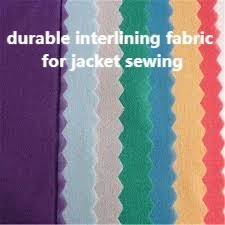Interlining-Factory Production Techniques For Efficient And High-Quality Apparel Manufacturing

Proper garment construction relies on the strategic use of Interlining to maintain shape, structure, and quality, and choosing the right Interlining ensures both durability and visual appeal. This foundational layer influences seam stability, garment drape, and overall aesthetics. Designers, manufacturers, and quality assurance teams benefit from understanding material types, handling techniques, and integration methods. This article provides a detailed overview of practical considerations for production, material selection, and functional applications, aimed at improving garment performance while reducing waste.
Material Types and Selection Criteria
Support layers are available in woven, nonwoven, and knitted forms, each offering unique characteristics. Lightweight versions suit delicate fabrics, while heavier variants provide rigidity for coats, jackets, and structured dresses. Heat-activated adhesives enable seamless bonding during pressing, facilitating wrinkle resistance and consistent finish. Evaluating fiber composition, density, and flexibility ensures the chosen material complements the outer fabric without altering texture or drape.
Functional Benefits in Garments
This foundational layer enhances garment stability, prevents stretching, and reinforces key areas like collars, cuffs, waistbands, and plackets. It also improves longevity by distributing stress across seams and maintaining tailored silhouettes. In luxury apparel, it contributes to a polished, high-end finish while balancing flexibility and comfort for the wearer.
Integration and Production Techniques
Proper handling is essential for consistent results. Accurate cutting, precise alignment, and controlled pressing prevent distortion or adhesion failure. Quality checks monitor thickness, surface smoothness, and bonding integrity to ensure uniform performance. Factories maintain strict procedural standards, reducing errors, minimizing waste, and optimizing throughput while safeguarding product quality.
Application Across Different Garment Styles
Different clothing types demand tailored reinforcement approaches. Delicate fabrics require soft, flexible layers to maintain drape without bulk. Structured garments, such as blazers and formal coats, benefit from denser layers for shape retention. Considerations include washability, breathability, and compatibility with decorative elements, ensuring functional and aesthetic harmony in finished garments.
Quality Control And Sustainable Practices
Routine inspection ensures adhesion, stability, and dimensional accuracy. Sustainable approaches include using eco-friendly fibers, minimizing cutting waste, and implementing proper storage to preserve material integrity. Combining high-quality support layers with responsible practices enhances product value, extends garment lifespan, and reduces environmental impact in modern apparel production.
In conclusion, selecting appropriate materials, employing precise integration techniques, and maintaining rigorous quality standards create garments with excellent structure, durability, and appearance. For further information on material types, applications, and practical guidance visit https://www.interlining-factory.com/news/what-is-interlining-types-applications-and-more.html
- Art
- Causes
- Crafts
- Dance
- Drinks
- Film
- Fitness
- Food
- Jeux
- Gardening
- Health
- Domicile
- Literature
- Music
- Networking
- Autre
- Party
- Religion
- Shopping
- Sports
- Theater
- Wellness

